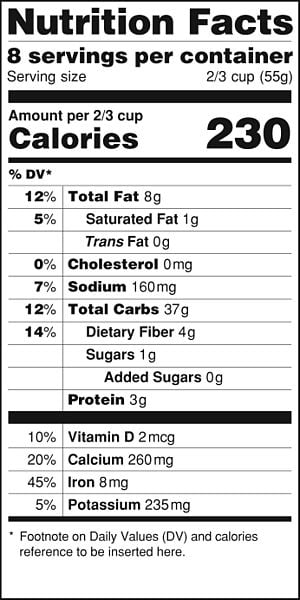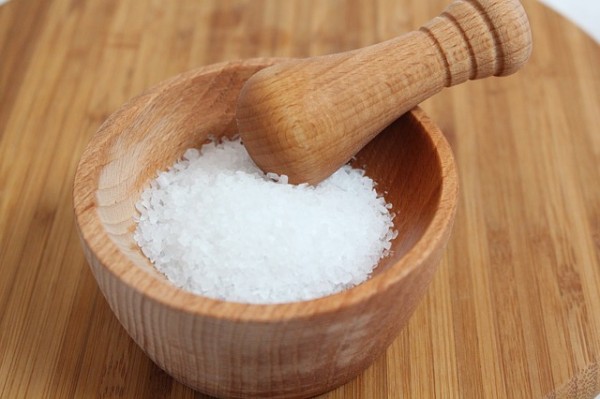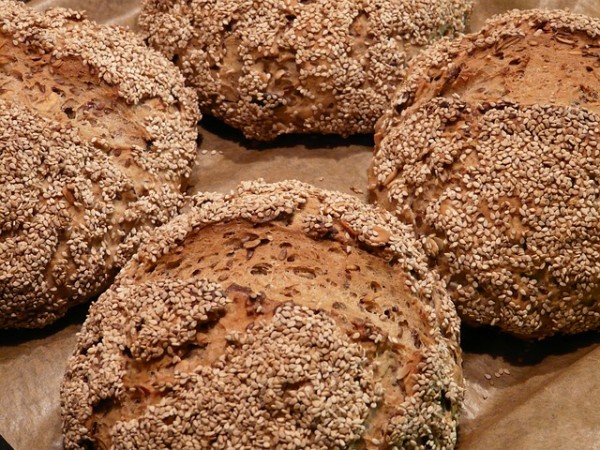How To Read Food Labels – 10 Tips
These 10 tips for how to read food labels are all about helping you shed excess weight, take good care of your heart, and live well. Tip No. 1 is: NEVER believe the claims on the front of the box.
Here are the basics for how to read food labels, consolidated into 10 quick-reference tips, compliments of Kimberly Gomer, Director of Nutrition at the Pritikin Longevity Center in Miami, Florida.
These 10 tips are all about helping you shed excess weight, take good care of your heart, and live well.
1. Never believe the claims on the front of the box.
What many think are health claims are actually just marketing pitches and advertisements. And government approved claims, like “low-fat” and “light,” often don’t tell you the whole story. These products may be high in fat as well as sugar, salt, and/or calories.
“Light” ice cream, for example, may still pack in 4 to 5 grams of fat per serving. And “light” and “regular” varieties of ice cream may not differ much calorically.
Never evaluate a product based on any one item, such as its fat, cholesterol, sugar, carbohydrate, or salt content. Attempting to cash in on the latest diet or nutrition craze, many companies promote their products based on a single item despite other unhealthy aspects. (Remember “fat-free” foods that were full of sugar and calories?) To be truly healthy, a product must pass several criteria.
 2. Always read the Nutrition Facts label and the ingredient list.
2. Always read the Nutrition Facts label and the ingredient list.
They contain information that can really help you determine how healthy a food is. Crackers, for example, may advertise on the front of the box that they’re “Trans Fat Free,” but in the ingredient list you may find fats, like palm oil and coconut oil, that are just as artery-clogging as the trans fats they replaced.
3. Check the serving size.
Though the government standardized most serving sizes years ago, many products still post unrealistically small sizes. A serving of oil spray, for instance, is .25 grams. That’s about 120th of an ounce – far less than most people could, or would, spray on a pan with even just one squirt.
4. Check the amount of servings per package.
Decades ago, many products were in fact single servings. A bottle of cola was one serving. One small candy bar was one serving. Today, many products are “super sized” and contain multiple servings. A 20-ounce bottle of soda contains 2.5 servings, at 110 calories each. Now, in the real world, who’s going to drink just one serving of that bottle? Is it any surprise that many of us are super-sized ourselves?
5. Check the calories per serving.
All too many people think the “110 calories” posted on that 20-ounce bottle of cola means they’re drinking 110 calories. Hardly. You’ve got to multiply the 110 calories by the total number of servings, 2.5, to realize that you’re actually downing a whopping 275 calories.
Don’t get too comfortable with “0”s either. Because some manufacturers use ridiculously small serving sizes (remember that 120th of an ounce of cooking spray?) and because the FDA states that manufacturers can “round down” to zero, some products advertised as calorie-free or fat-free are not. If you eat multiple servings – if, say, you coat an entire skillet with oil spray – you may be tallying up quite a few calories.
6. Check the calories from fat.
It’s on the Nutrition Facts label. Unfortunately, it doesn’t tell you “percent of calories from fat,” which is how all health guidelines direct us to limit fat. You’ve got to do a little math. Divide the number of calories from fat by the total calories. (If the serving’s 150 calories, 50 of which are fat, your product is 33% calories from fat.).
If division trips you up, go by grams. Use this easy rule. If a product has 2 grams of fat or less per 100 calories, its fat content is within Pritikin guidelines for processed foods: the fat, per serving, is 20% or less of total calories. You don’t have to be a mathematician to realize that 4 grams of fat per 100 calories is double the fat recommended by the Pritikin Eating Plan.
Don’t be fooled by claims like “99% fat-free” soup or “2% fat” milk. They’re based on percent of weight, not percent of calories. So that can of 99% fat-free soup may actually have 77% of its calories from fat, or more. And 2% fat milk actually has about 34% of total calories from fat; 1% milk has about 23% calories from fat.

Learn More About Pritikin
 7. Check the sodium.
7. Check the sodium.
Don’t bother with the percentage of Daily Value (DV) of sodium. Don’t bother with Daily Value percentages, period. They’re based on government standards, which are generally not as healthful as Pritikin Program guidelines.
Instead, look at the number of milligrams of sodium the serving contains. A great rule of thumb: Limit the sodium in milligrams to no more than the number of calories in each serving. Your daily goal: less than 1,500mg of sodium. That’s been the daily recommendation for sodium on the Pritikin Program for nearly 40 years, and it is now the recommendation of many leading healthy authorities, including the American Heart Association and the Centers for Disease Control and Prevention.
8. Check the types of fat.
Make sure there are no saturated fats, partially hydrogenated fats, or tropical oils in the ingredient list, including lard, butter, coconut, cocoa butter, palm oils, shortening, margarine, chocolate, and whole and part-skim dairy products. They’re all damaging to your arteries and heart.
Polyunsaturated fats (like safflower, soybean, corn, and sesame) and monounsaturated fats (such as olive and canola) are less harmful and would be acceptable, but make sure the percent calories from fat are still in line – 20% calories from fat or less – or your waistline may start getting out of line. All oils, even “good” oils, are dense with calories.
9. Check the sugar.
Limit caloric sweeteners. Watch out for sugars and other caloric sweeteners that don’t say “sugar” but in fact are, such as corn syrup, rice and maple syrup, molasses, honey, malted barley, barley malt, or any term that ends in “ol,” such as sorbitol or maltitol, or “ose,” such as dextrose or fructose.
Try to limit all these added, refined, concentrated sugars to no more than 5% of total calories (essentially, no more than 2 tablespoons daily for most folks). Don’t be concerned about naturally occurring sugars in fruit and some nonfat dairy products. However, on the Nutrition Facts label, added sugars and naturally occurring sugars are all lumped together as “sugar.”
Your best bet: Look at the ingredient list. Try to avoid foods with added, refined caloric sweeteners in the first three to five ingredients. Because ingredients are listed in descending order of weight, the lower down the label you find added sugars, the better.
 10. Make sure that any grain is WHOLE grain, such as whole-wheat flour.
10. Make sure that any grain is WHOLE grain, such as whole-wheat flour.
Many bread and pasta products claim to be whole wheat, but the first ingredient in the ingredient list is often wheat flour, which sounds healthy, but it’s really refined flour. Further down the list will be whole-wheat flour or bran. Scout out products that contain only whole grains. And look for at least 3 grams of fiber per serving, which often ensures the product is mostly, if not all, whole grain.
If the product sounds too good to be true, it may be. Thousands of new products come out every year, many trying to cash in on the latest diet craze. Many may not be carefully regulated (if at all). Recently the Florida FDA evaluated 67 diet products and found all 67 were inaccurately labeled; they contained more sugar, for example, than their labels stated. And recently, consumer laboratories evaluated 30 low-carb nutrition bars and found that 60% were inaccurately labeled. Most had more carbs, sugars, and salt than their labels claimed.
During your first few trips to the market, give yourself extra time to evaluate products. You’ll soon speed up! Once you’ve found products that you enjoy and that meet these healthy guidelines, shopping becomes quick and easy. Your health is worth it!!

Get All the Details of a Stay at the Pritikin Center in Your Inbox
Wellness Resort
Weight Loss Retreat
Health Spa